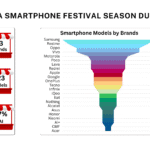Artificial intelligence (AI) is rapidly transforming the technological landscape, reshaping industries, and enhancing everyday experiences. By simulating human intelligence, AI systems are designed to learn from experience, make informed decisions, and perform tasks that traditionally required human intellect. This evolution can lead to significant advancements in various sectors, including healthcare, finance, education, and media. As AI continues to develop, it is increasingly recognized for its potential to improve efficiency, accuracy, and productivity across diverse applications.
In this context of technological innovation, the demand for versatile devices that can adapt to a range of tasks has surged. Tablets is one such category of devices that has gained prominence as powerful tools for both personal and professional use of consumers. Tablets are not just portable media consumption devices but have evolved into multifunctional platforms capable of managing a wide array of applications—from productivity apps to creative design tools. The popularisation of tablets has been driven by an increasing consumer preference for devices that offer flexibility and convenience in a compact and mobile format.
Tablet adoption has experienced varying levels of popularity over time, but recent trends suggest a renewed interest in these devices. Factors such as remote work, online learning, and the need for portable computing solutions have contributed to this revival. Consumers are now seeking tablets that not only facilitate media consumption but also support complex professional and creative activities. The integration of AI into tablets is essential to meet the increasing demand for smarter, more efficient devices that enhance both productivity and creativity. This shift in user expectations underscores the importance of integrating AI into tablets, enhancing their functionality and usability.

Overcoming Barriers to Adoption
The integration of AI into tablet technology is crucial for overcoming existing barriers to broader adoption and enhancing content creation capabilities. One significant impediment is the challenge users face with traditional input methods. For example, typing on a tablet’s soft keyboard can be uncomfortable and inefficient without a hard surface. AI can address this by enabling voice-to-text capabilities that allow users to dictate their thoughts seamlessly. This feature not only enhances productivity but also makes content creation more accessible for users who may struggle with typing.
Optimizing Performance for Different Use Cases
AI can optimize resource deployment on tablets based on specific use cases. For instance, during gaming sessions, AI can dynamically allocate processing power to ensure smooth graphics and responsive gameplay while managing battery consumption effectively. Conversely, when engaging in simpler tasks like reading or browsing the web, AI can conserve resources to extend battery life and enhance overall performance.
Personalizing the User Experience
Personalisation is another area where AI can enhance the user experience in tablets. Smart recommendation systems can analyse viewing habits and suggest relevant content tailored to individual preferences. This capability will transform how users interact with media on their tablets, making the experience more engaging and enjoyable.
Enhancing Content Creation with AI
When it comes to content creation specifically, several tablet accessories often fall short of providing an ergonomic experience. Traditional keyboards may not be comfortable for extended typing sessions, leading to frustration among users. Here again, AI can play a pivotal role by offering intelligent text generation features that reduce reliance on physical keyboards. Users could simply input prompts or ideas into an AI-powered application that generates coherent text based on their input.
AI for Stylus-Like Functionality
Professionals, especially in the creative fields rely on styluses for tasks such as drawing or note-taking due to comfort or precision that stylus provides. However, carrying a stylus separately can be inconvenient and the risk of losing/damaging it always remains. AI-driven features can mitigate these issues by introducing stylus-like functionalities through touch gestures or voice commands. For instance, users could draw or annotate directly on their screens using finger gestures while AI interprets these inputs as precise strokes or shapes.
AI-Driven Features in Tablets
Microsoft has enhanced its Surface Pro line with AI capabilities (Copilot+) that help in generating summaries, creating to-do lists and provide intelligent suggestions for text completion and rewriting notes for clarity within applications like OneNote, among others. Similarly, Samsung’s Galaxy AI features are being implemented across its tablet range, enhancing user interaction through personalized experiences and smart functionalities. The launch of the MILKYWAY tablet in India showcases an education-focused approach by integrating AI (India’s homegrown BharatGPT) for language translation and personalized learning experiences.
The Future of AI in Tablets
The continued integration of AI into tablet technology is transforming both functionality and user experience. From resource optimization during gaming to personalized media recommendations, AI is expanding the creative and professional potential of tablets. Innovations like Copilot+ in Microsoft Surface Pro and BharatGPT in the MILKYWAY tablet are setting the stage for a future where AI-powered tablets will redefine user engagement across various sectors, making them more intelligent and adaptable to evolving needs. These ongoing advancements indicate a future where tablets equipped with AI will play a crucial role in various sectors, driving innovation and improving user experiences globally.
(With inputs from an industry interaction with Mr. Pankaj Harjai, Asia Pacific and Japan Leader & Director at Lenovo for Tablets, Visuals & Accessories.)





